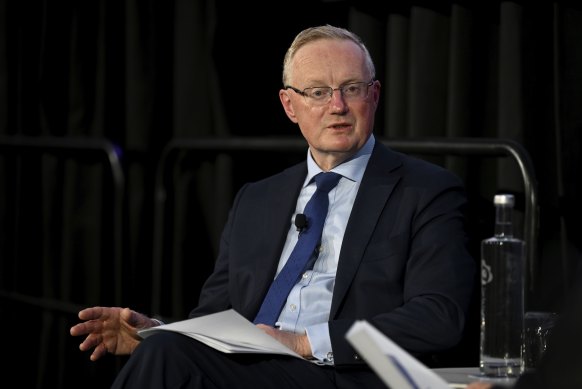Save articles for later
Add articles to your saved list and come back to them any time.
The collective sigh of relief that could be heard at 11.30am on Wednesday was Australian borrowers digesting the good news that inflation came in lower than expected. The other noise was the flurry of futures traders adjusting the odds of an interest rate rise next week from almost 60 per cent to less than 30 per cent.
Australia has not yet won the war on inflation – although the news of it slowing to 6 per cent annually to June is good progress.
Will Reserve Bank governor Philip Lowe raise rates next week?Credit: Dan Peled
There is certainly a school of economists who believe the latest inflation number demonstrates sufficient progress has been made in the inflation fight that the Reserve Bank can down its monetary gun and leave rates where they are.
There is another cohort of economists who believe the central bank has one interest rate bullet to fire. But those who were predicting two more rate rises are disappearing fast.
Wednesday’s inflation number is also grist for the position taken by some high-profile economists, such as Deloitte Access Economics partner Stephen Smith and the AMP’s Shane Oliver, that the RBA already has overdone interest rates rises and is playing Russian roulette with the economy.
The reason the inflation battle has not been declared over is that services inflation remains a pocket of resistance – and it’s a front that is closely watched by the Reserve Bank as it deliberates when or whether it will need to raise interest rates one last time.
Australia isn’t alone in this fight. Taming services inflation is proving to be difficult for central banks around the world. In Australia, services inflation recorded its largest annual rise in the 12 months to June for more than 20 years.
The biggest culprits contributing to this record are rents (the largest component in services), which rose 6.7 per cent for the year and 2.5 per cent for the quarter, insurance (up a hearty 8.5 per cent for the year), holiday travel and eating out.
Demand for international travel has been strong particularly in the June quarter, which has put upward pressure on airfares – a bonus for airlines such as Qantas, which is set to announce record profit for the 2023 year and Flight Centre which upgraded its profit guidance last week.
Insurance companies have also received a re-rating by stock market analysts on the back of increased premiums. The latest data set on inflation justifies that position.
The Australian Bureau of Statistics says that higher wages, rents and utilities were contributing to higher input costs for those operating in services, but pricing power has also played a significant part.
Overall, services contribute 45 per cent of the consumer price index and goods make up 55 per cent, so tackling services inflation is essential to fight inflation.
The good news is that goods inflation is coming down faster than expected. Clothing and footwear were up only 0.3 per cent year-on-year, supporting analysts’ warnings that apparel retailers are set for a lean period ahead.
Household furniture and equipment delivered an unusually robust gain of 6.3 per cent for the year and 2.1 per cent for the quarter, which contrasts with warnings from companies such as Harvey Norman that warned of a slide in earnings this year.
Those like Smith, who sit in the camp that say the Reserve Bank has already gone too far on raising rates, reason that inflation has been caused by supply-side factors, and thus that interest rate increases have been mostly ineffective at bringing inflation under control. Rather, they say, inflation has fallen as a result of repairs to global supply chains and an easing of import prices.
When it comes to excessive growth in rents, supply is clearly the major problem, and it is one that increased immigration only exacerbates.
Everyone agrees the dearth of housing stock is pushing up rents. And perversely, raising rates only deters investment into building more housing. This is one area that needs government intervention.
The latest inflation numbers signal that Reserve Bank governor Philip Lowe has a tough call to make. He has only two more opportunities to raise rates before he leaves the job.
It is hard to believe he won’t use one of them either in August or September.
The Business Briefing newsletter delivers major stories, exclusive coverage and expert opinion. Sign up to get it every weekday morning.
Most Viewed in Business
From our partners
Source: Read Full Article

